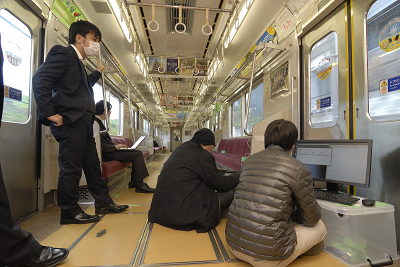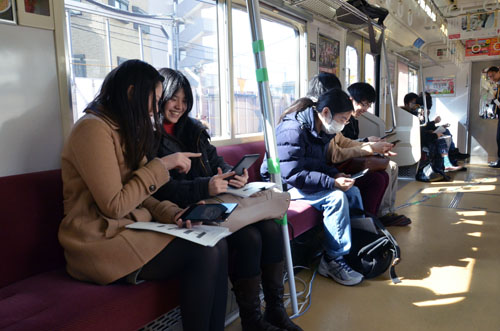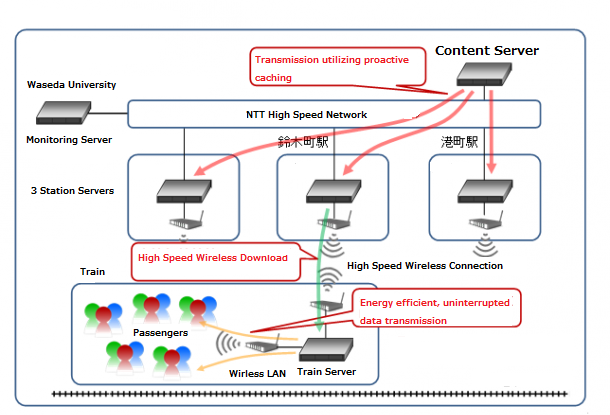Waseda University
University of Electro-Communications
Fujitsu Kyushu Network Technologies Ltd.
Proactive Caching technique delivers high-definition video streaming on railroad transportation systems
Test conducted on Keikyu Daishi Line in February
Waseda University, the University of Electro-Communications, and Fujitsu Kyushu Network Technologies Ltd. have successfully developed and verified a technique that utilizes proactive caching to deliver high-definition video streaming on railroad transportation systems.
In collaboration with Keihin Electric Express Railway Ltd. and Nippon Telegraph and Telephone East Corporation, the research group tested and verified the proactive caching system using the Keikyu Daishi Line on February 20th 2015. This proactive caching system enables users to continuously stream high-definition content during transit and despite high-volume data traffic.
The proactive caching technique used on the Keikyu Daishi Line is based on the Ministry of Internal Affairs and Communications’ “Proactive Content Caching utilizing Transportation Systems” method which was developed by Waseda University Professor Takuro Sato. This new technique will contribute to the creation of new markets that result from the fusion of transportation and communication systems and strengthen communications infrastructure.
Background:
According to Cisco Systems, Inc. the amount of mobile data traffic in 2019 will be 10 times greater than that in 2014. Mobile video data in particular will contribute to 70% of all mobile data traffic. As the 2020 Olympics approaches and foreigners arrive in Japan, there are expected to be increased opportunities to access mobile content. However, the current wireless network infrastructure is not sufficient in handling network congestion and results in dropped connections and frozen content. As 4k and 8K definition video formats become commonplace, the amount of data required to stream such content is expected to increase exponentially. In response to these issues, highly effective and reliable systems that transform transportation systems into a communications platform and utilize next generation Named Data Neworking (NDN) architecture are being tested and verified.
Development
Proactive Caching
Digital content is generally transmitted in packets of data through a stable network connection between the content server and user. As a result, wireless connections often result in low quality transmissions due to movement and network congestion. Proactive caching addresses this issue by partitioning and distributing data transmitted from content sever to user utilizing a train station server. When a train arrives at a station, a train server duplicates the content from the train station server and transmits the content to the user while the train is in transit.
This proactive caching technique is capable of transmitting data without drops in quality. Especially effective in transmitting video content, the multi-bitrate MPEG-DASH (Dynamic Adaptive Streaming over HTTP) format improves the viewer’s experience by transmitting content that best matches network conditions. Users do not require a constant cellular connection as close range transmission is conducted within the train. This characteristic will be particularly effective in regions without strong cellular infrastructure. It is also possible to immediately access popular content accessed using train servers.
Operation Test Focus
- Proactive caching timing in relation to transit and arrival times
- High speed connection between train servers and train station servers
- NDN and IP transmission methods
Testbed
Thanks to the organizations involved, an expansive area was utilized for the operation test with constructed servers and wireless access points. An IP network and NDN overlay network was also prepared prior to the operation test. The quality of content sent using the content server, train station server, train server, and wireless LAN access point was verified prior to the operation test.
Operation Test Preparation
Keihin Electric Express Railway and Nippon Telegraph and Telephone Communication conducted regular meetings in preparation for the operation test.
Three stations on the Daishi Line (Minatocho, Suzukicho, and Kawasaki-Daishi) were selected for the operation test. It takes approximately 9 minutes to travel from the first to last station of the Daishi Line (7 lines in total) and the above mentioned stations (located next to each other in the middle of the line) were selected in order to ensure an appropriate number of round trips. Storage containers with a server and LAN access point were placed in each station and were accessible similar to that of a public wireless service. The network was connected to Waseda University where it could be monitored. Approximately 50 personnel and students participated in the test and evaluated the network using notepads and laptops.
Operation Test
The image below provides a general idea of the test operation. As the Daishi line arrives at the three LAN equipped stations, video content is downloaded through proactive caching to the train server, enabling uninterrupted video streaming to users inside the train. Other methods of transmission including NDN and IP transmission are also being investigated.
References
Waseda University
School of Fundamental Science and Engineering
Department of Communications and Computer Engineering, Jiro Katto
- 3-4-1 Okubo, Shinjuku-ku, Tokyo 169-0072
- Telephone: 03-5286-3393
Office of Information and Public Relations
- Telephone: 03-3202-5454
University of Electro-Communications
School of Information Science and Technology, Masatsugu Ichino
- 1-5-1 Chofugaoka, Chofu-shi, Tokyo 182-0021
- Telephone: 042-443-5977
Information and Public Relations
- Telephone: 042-443-5019
Fujitsu Kyushu Network Technologies Ltd.
- Fujitsu Kyushu R&D Center, 2-2-1 Momochihama, Sawara-ku, Fukuoka-ken
- Telephone: 092-852-8501











